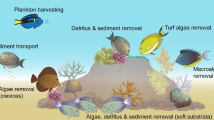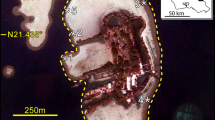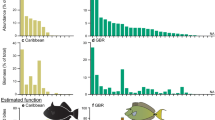Abstract
Allochthonous subsidies of energy and nutrients can affect community structure in patchy marine habitats, including rocky reefs, and their ecological consequences may depend on the mechanism of energy transfer. Lingcod (Ophiodon elongatus) are demersal predators that trophically link nearshore rocky reefs with offshore pelagic habitats through consumption of pelagic fishes. We quantified lingcod habitat use and movement patterns to make inferences about the temporal and spatial conditions under which lingcod may acquire pelagic prey. Lingcod maintained small home ranges (21,272 ± 13,630 m2) within a rocky reef in the San Juan Archipelago, Washington; eight of nine individuals used rocky habitat exclusively. Depths occupied by lingcod (0–50 m) coincided with pelagic fish distribution on the rocky reef; however, diel patterns in lingcod activity varied inversely with occurrence of pelagic fishes on the reef. Our findings suggest that the pelagic subsidy to lingcod is not strongly mediated through directed off-reef foraging by lingcod.




Similar content being viewed by others
References
Anderson WB, Wait DA, Stapp P (2008) Resources from another place and time: responses to pulses in a spatially subsidized system. Ecology 89:660–670. doi:10.1890/07-0234.1
Arnold G, Dewar H (2001) Electronic tags in marine fisheries research: a 30-year perspective. In: Sibert JR, Nielsen JL (eds) Electronic tagging and tracking in marine fisheries. Kluwer Academic Publishers, Dordrecht, pp 7–64
Axenrot T, Hansson S (2004) Seasonal dynamics in pelagic fish abundance in a Baltic Sea coastal area. Estuar Coast Shelf Sci 60:541–547. doi:10.1016/j.ecss.2004.02.004
Axenrot T, Didrikas T, Danielsson C, Hansson S (2004) Diel patterns in pelagic fish behaviour and distribution observed from a stationary, bottom-mounted, and upward-facing transducer. ICES J Mar Sci 61:1100–1104. doi:10.1016/j.icesjms.2004.07.006
Baldwin CM, Beauchamp DA, Gubala CP (2002) Seasonal and diel distribution and movement of cutthroat trout from ultrasonic telemetry. Trans Am Fish Soc 131:143–158. doi:10.1577/1548-8659(2002)131<0143:SADDAM>2.0.CO;2
Banas N, Bricker J, Carter G, Gerdes F, Martin W, Nelson E, Ross T, Scansen B, Simons R, Wells M (1999) Flow, stratification, and mixing in the San Juan Channel. Coastal and Estuarine Geophysical Fluid Dynamics Oc590b. Friday Harbor Laboratories, University of Washington, Friday Harbor
Barros F, Underwood AJ, Lindegarth M (2001) The influence of rocky reefs on structure of benthic macrofauna in nearby soft-sediments. Estuar Coast Shelf Sci 52:191–199. doi:10.1006/ecss.2000.0734
Beauchamp DA, Baldwin CM, Vogel JL, Gubala CP (1999) Estimating diel, depth-specific foraging opportunities with a visual encounter rate model for pelagic piscivores. Can J Fish Aquat Sci 56:128–139. doi:10.1139/cjfas-56-S1-128
Beaudreau AH (2009) The predatory role of lingcod (Ophiodon elongatus) in the San Juan Archipelago, Washington. Dissertation, University of Washington, Seattle
Beaudreau AH, Essington TE (2009) Development of a new field-based approach for estimating consumption rates of fishes and comparison with a bioenergetics model for lingcod (Ophiodon elongatus). Can J Fish Aquat Sci 66:565–578. doi:10.1139/F09-021
Bomkamp RE, Page HM, Dugan JE (2004) Role of food subsidies and habitat structure in influencing benthic communities of shell mounds at sites of existing and former offshore oil platforms. Mar Biol 146:201–211. doi:10.1007/s00227-004-1413-8
Burd BJ, Barnes PAG, Wright CA, Thomson RE (2008) A review of subtidal benthic habitats and invertebrate biota of the Strait of Georgia, British Columbia. Mar Environ Res 66:S3–S38. doi:10.1016/j.marenvres.2008.09.004
Burnham KP, Anderson DR (2002) Model selection and multimodel inference: a practical information-theoretic approach. Springer Science + Business Media Inc., New York
Caley MJ, Carr MH, Hixon MA, Hughes TP, Jones GP, Menge BA (1996) Recruitment and the local dynamics of open marine populations. Annu Rev Ecol Syst 27:477–500. doi:10.1146/annurev.ecolsys.27.1.477
Cardinale M, Casini M, Arrhenius F, Hakansson N (2003) Diel spatial distribution and feeding activity of herring (Clupea harengus) and sprat (Sprattus sprattus) in the Baltic Sea. Aquat Living Resour 16:283–292. doi:10.1016/S0990-7440(03)00007-X
Chaves LCT, Monteiro-Neto C (2009) Comparative analysis of rocky reef fish community structure in coastal islands of south-eastern Brazil. J Mar Biol Assoc UK 89:609–619. doi:10.1017/S0025315408002695
Coates J, Gunderson DR, LaFrance L, Miller BS, Goetz B, Palsson WA (2007) Changes in growth and recruitment of Puget Sound rockfish (Sebastes emphaeus) in northern Puget Sound. University of Alaska College Sea Grant Program Report, No. AK-SG-07-01
Emmett RL, Brodeur RD, Orton PM (2004) The vertical distribution of juvenile salmon (Oncorhynchus spp.) and associated fishes in the Columbia River plume. Fish Oceanogr 13:392–402. doi:10.1111/j.1365-2419.2004.00294.x
Faraway JJ (2006) Extending the linear model with R. Chapman & Hall/CRC, Boca Raton
Fresh KL (1979) Distribution and abundance of fishes occurring in the nearshore surface waters of northern Puget Sound, Washington. Master’s Thesis, University of Washington, Seattle
Galvan DE, Botto F, Parma AM, Bandieri L, Mohamed N, Iribarne OO (2009) Food partitioning and spatial subsidy in shelter-limited fishes inhabiting patchy reefs of Patagonia. J Fish Biol 75:2585–2605. doi:10.1111/j.1095-8649.2009.02453.x
Greene HG, Yoklavich MM, Starr RM, O’Connell VM, Wakefield WW, Sullivan DE, McRea JE Jr, Cailliet GM (1999) A classification scheme for deep seafloor habitats. Oceanol Acta 22:663–678. doi:10.1016/S0399-1784(00)88957-4
Greene HG, Bizzarro JJ, O’Connell VM, Brylinsky CK (2007) Construction of digital potential marine benthic habitat maps using a coded classification scheme and its application. In: Todd BJ, Greene HG (eds) Mapping the seafloor for habitat characterization, Canadian Geological Association Special Paper vol 47. pp 141–155
Gunderson DR, Vetter RD (2006) Temperate rocky reef fishes. In: Kritzer JP, Sale PF (eds) Marine metapopulations. Elsevier Academic Press, Amsterdam, pp 69–117
Gunderson DR, Parma AM, Hilborn R, Cope JM, Fluharty DL, Miller ML, Vetter RD, Heppell SS, Greene HG (2008) The challenge of managing nearshore rocky reef resources. Fisheries 33:172–179. doi:10.1577/1548-8446-33.4.172
Gustafson RG, Drake J, Ford MJ, Myers JM, Holmes EE, Waples RS (2006) Status review of Cherry Point Pacific herring (Clupea pallasii) and updated status review of the Georgia Basin Pacific herring distinct population segment under the Endangered Species Act. NOAA Fisheries Northwest Fisheries Science Center, Seattle, Washington. NOAA Technical Memorandum NMFS-NWFSC-76, 203 pp
Helfield JM, Naiman RJ (2001) Effects of salmon-derived nitrogen on riparian forest growth and implications for stream productivity. Ecology 82:2403–2409. doi:10.1890/0012-9658(2001)082[2403:EOSDNO]2.0.CO;2
Hobson ES (1986) Predation on the Pacific sand lance, Ammodytes hexapterus (Pices: Ammodytidae), during the transition between day and night in southeastern Alaska. Copeia 1986:223–226. doi:10.2307/1444914
Holt RD (1977) Predation, apparent competition, and the structure of prey communities. Theor Popul Biol 12:197–229. doi:10.1016/0040-5809(77)90042-9
Holt RD (1984) Spatial heterogeneity, indirect interactions, and the coexistence of prey species. Am Nat 124:377–406. doi:10.1086/284280
Huxel GR, McCann K (1998) Food web stability: the influence of trophic flows across habitats. Am Nat 152:460–469. doi:10.1086/286182
Lance MM, Jeffries SJ (2007) Temporal and spatial variability of harbor seal diet in the San Juan Island archipelago. Contract Report to SeaDoc Society Research Agreement No. K004431-25. Washington Department of Fish and Wildlife, Olympia, 21 pp
Lance MM, Thompson CW (2005) Overlap in diets and foraging of common murres (Uria aalge) and rhinoceros auklets (Cerorhinca monocerata) after the breeding season. Auk 122:887–901. doi:10.1642/0004-8038(2005)122[0887:OIDAFO]2.0.CO;2
Laver PN, Kelly MJ (2008) A critical review of home range studies. J Wildl Manage 72:290–298. doi:10.2193/2005-589
Leroux SJ, Loreau M (2008) Subsidy hypothesis and strength of trophic cascades across ecosystems. Ecol Lett 11:1147–1156. doi:10.1111/j.1461-0248.2008.01235.x
Levin SA (1992) The problem of pattern and scale in ecology: the Robert H. MacArthur award lecture. Ecology 73:1943–1967. doi:10.2307/1941447
Love M, Yoklavich M, Thorsteinson L (2002) The rockfishes of the Northeast Pacific. University of California Press, Berkeley
Lowe CG, Topping DT, Cartamil DP, Papastamatiou YP (2003) Movement patterns, home range, and habitat utilization of adult kelp bass Paralabrax clathratus in a temperate no-take marine reserve. Mar Ecol Prog Ser 256:205–216. doi:10.3354/meps256205
Matthews KR (1990) A telemetric study of the home ranges and homing routes of copper and quillback rockfishes on shallow rocky reefs. Can J Zool 68:2243–2250. doi:10.1139/z90-312
Matthews K (1992) A telemetric study of the home ranges and homing routes of lingcod Ophiodon elongatus on shallow rocky reefs off Vancouver Island, British Columbia. Fish Bull 90:784–790
McCann KS, Rasmussen JB, Umbanhowar J (2005) The dynamics of spatially coupled food webs. Ecol Lett 8:513–523. doi:10.1111/j.1461-0248.2005.00742.x
Miller DJ, Geibel JJ (1973) Summary of blue rockfish and lingcod life histories: a reef ecology study; and giant kelp, Macrocystis pyrifera, experiments in Monterey Bay, California. Calif Dept Fish Game Fish Bull 158, 135 pp
Mulcahy DM (2003) Surgical implantation of transmitters into fish. ILAR J 44:295–306
Olesiuk PF (1993) Annual prey consumption by harbor seals (Phoca vitulina) in the Strait of Georgia, British Columbia. Fish Bull 91:491–515
Orlov OY, Kondrashev SL (1998) Changeable coloration of cornea in fishes and its distribution. Iugosl Physiol Pharmacol Acta 34:359–369
Pacunski RE, Palsson WA (1998) The distribution and abundance of nearshore rocky-reef habitats and fishes in Puget Sound. Puget Sound Research Conference. Puget Sound Water Quality Action Team, Seattle, WA
Polis GA, Hurd SD (1995) Extraordinarily high spider densities on islands: flow of energy from the marine to terrestrial food webs and the absence of predation. Proc Natl Acad Sci USA 92:4382–4386. doi:10.1073/pnas.92.10.4382
Polis GA, Strong DR (1996) Food web complexity and community dynamics. Am Nat 147:813–846. doi:10.1086/285880
Polis GA, Anderson WB, Holt RD (1997) Toward an integration of landscape and food web ecology: the dynamics of spatially subsidized food webs. Annu Rev Ecol Syst 28:289–316. doi:10.1146/annurev.ecolsys.28.1.289
Rodriguez SR (2003) Consumption of drift kelp by intertidal populations of the sea urchin Tetrapygus niger on the central Chilean coast: possible consequences at different ecological levels. Mar Ecol Prog Ser 251:141–151. doi:10.3354/meps251141
Schindler DE, Scheuerell MD (2002) Habitat coupling in lake ecosystems. Oikos 98:177–189. doi:10.1034/j.1600-0706.2002.980201.x
Simenstad C, Miller B, Nyblade C, Thornburgh K, Bledsoe L (1979) Food web relationships of northern Puget Sound and the Strait of Juan de Fuca: a synthesis of available knowledge. NOAA-EPA-600/7-79-259
Smith BD, McFarlane GA, Cass AJ (1990) Movements and mortality of tagged male and female lingcod in the Strait of Georgia, British Columbia. Trans Am Fish Soc 119:813–824. doi:10.1577/1548-8659(1990)119<0813:MAMOTM>2.3.CO;2
Starr R, O’Connell V, Ralston S (2004) Movements of lingcod (Ophiodon elongatus) in southeast Alaska: potential for increased conservation and yield from marine reserves. Can J Fish Aquat Sci 61:1083–1094. doi:10.1139/f04-054
Stephens JS Jr, Larson RJ, Pondella DJ (2006) Rocky reefs and kelp beds. In: Allen LG, Pondella DJ, Horn MH (eds) The ecology of marine fishes: California and adjacent waters. University of California Press, Berkeley, pp 227–252
Stick K (2004) 2004 Washington State herring stock status report. Fish Management Division, Washington Department of Fish and Wildlife, Olympia, 86 pp
Stout HA, Gustafson RG, Lenarz WH, McCain BB, VanDoornik DM, Builder TL, Methot RD (2001) Status review of Pacific herring (Clupea pallasi) in Puget Sound, Washington. NOAA Technical Memorandum NMFS-NWFSC-45. NOAA Fisheries Northwest Fisheries Science Center, Newport
Tolimieri N, Andrews K, Williams G, Katz S, Levin PS (2009) Home range size and patterns of space use for lingcod, copper rockfish and quillback rockfish in Puget Sound in relation to diel and tidal cycles. Mar Ecol Prog Ser 380:229–243. doi:10.3354/meps07930
U.S. Naval Observatory (2008) Sunrise, sunset, and nautical twilight tables for Friday Harbor, WA. http://aa.usno.navy.mil/data/. Accessed 12 August 2008
Valentine JF, Heck KL Jr, Blackmon D, Goecker ME, Christian J, Kroutil RM, Kirsch KD, Peterson BJ, Beck M, Vanderklift MA (2007) Food web interactions along seagrass-coral reef boundaries: effects of piscivore reductions on cross-habitat energy exchange. Mar Ecol Prog Ser 333:37–50. doi:10.3354/meps333037
Vanderklift MA, Wernberg T (2008) Detached kelps from distant sources are a food subsidy for sea urchins. Oecologia 157:327–335. doi:10.1007/s00442-008-1061-7
Varpe O, Fiksen O, Slotte A (2005) Meta-ecosystems and biological energy transport from ocean to coast: the ecological importance of herring migration. Oecologia 146:443–451. doi:10.1007/s00442-005-0219-9
Walters CJ, Martell SJ (2004) Fisheries ecology and management. Princeton University Press, Princeton
Watt J, Siniff DB, Estes JA (2000) Inter-decadal patterns of population and dietary change in sea otters at Amchitka Island, Alaska. Oecologia 124:289–298. doi:10.1007/s004420000373
Wernberg T, Vanderklift MA, How J, Lavery PS (2006) Export of detached macroalgae from reefs to adjacent seagrass beds. Oecologia 147:692–701. doi:10.1007/s00442-005-0318-7
Wilby GV (1937) The lingcod, Ophiodon elongatus Girard. Fish Res Board Can Bull 54, 24 pp
Willis TJ, Anderson MJ (2003) Structure of cryptic reef fish assemblages: relationships with habitat characteristics and predator density. Mar Ecol Prog Ser 257:209–221. doi:10.3354/meps257209
Winter J (1996) Advances in underwater biotelemetry. In: Murphy BR, Willis DW (eds) Fisheries techniques. American Fisheries Society, Bethesda, pp 555–590
Withler RE, King JR, Marliave JB, Beaith B, Li S, Supernault KJ, Miller KM (2004) Polygamous mating and high levels of genetic variation in lingcod, Ophiodon elongatus, of the Strait of Georgia, British Columbia. Environ Biol Fish 69:345–357. doi:10.1023/B:EBFI.0000022898.49007.bc
Worton BJ (1989) Kernel methods for estimating the utilization distribution in home-range studies. Ecology 70:164–168. doi:10.2307/1938423
Zamon JE (2001) Seal predation on salmon and forage fish schools as a function of tidal currents in the San Juan Islands, Washington, USA. Fish Oceanogr 10:353–366. doi:10.1046/j.1365-2419.2001.00180.x
Zamon JE (2003) Mixed species aggregations feeding upon herring and sandlance schools in a nearshore archipelago depend on flooding tidal currents. Mar Ecol Prog Ser 261:243–255. doi:10.3354/meps261243
Acknowledgments
Funding for A.H.B. and field work was provided by the National Science Foundation, ARCS Foundation, and the University of Washington School of Aquatic and Fishery Sciences. Thanks to Friday Harbor Laboratories, T. Quinn, D. Beauchamp, and W. Ruef for facilities and equipment and H.G. Greene and C. Endris at Moss Landing Marine Laboratories for habitat and bathymetry data. P. Levin, K. Andrews, G. Williams, and N. Tolimieri of NOAA Northwest Fisheries Science Center provided field assistance and helpful discussion. Thanks to anonymous reviewers, D. Beauchamp, A. Frid, D. Gunderson, M. Logsdon, S. Parker-Stetter, E. Schoen, and J. Ruesink for their valuable comments. We thank A. Dufault for his excellent work as a field assistant and many volunteers who participated in field sampling, especially C. Sergeant, K. Matterson, K. Turner, N. Overman, and P. Kitaeff. The research complies with all applicable United States laws, and the authors declare that they have no conflicts of interest.
Author information
Authors and Affiliations
Corresponding author
Additional information
Communicated by D. Goulet.
Rights and permissions
About this article
Cite this article
Beaudreau, A.H., Essington, T.E. Use of pelagic prey subsidies by demersal predators in rocky reefs: insight from movement patterns of lingcod. Mar Biol 158, 471–483 (2011). https://doi.org/10.1007/s00227-010-1574-6
Received:
Accepted:
Published:
Issue Date:
DOI: https://doi.org/10.1007/s00227-010-1574-6




